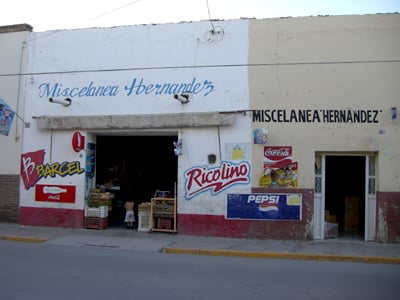Photovoltaic Feasibility Study for Local Grocer:

Jose Leandro Hernandez, a local grocer in Parras, Coahuila MX, is interested in harnessing the ample year-round sunshine that Parras receives to power his store. The grocer is willing to invest in a photovoltaic system, but first needs to determine the economic feasibility of the project. Our goal was to design a system suited to the grocer´s needs and conduct a thorough study to determine the feasibility of the project.
We first designed a stand-alone system and found that the payback time is more than 25 years (the expected life of the system). We then designed a grid intertie system with a payback of 11 years. The stand alone system has more components and is far more expensive than the grid intertie system. With the intertie system, the grocer could produce more energy than he uses during the day and feed that energy into the grid (saving a lot of money on batteries) and then draw a similar amount of energy back from the grid at night when the panels aren't producing.
Unfortunately, grid intertie systems aren't legal in Mexico. Connecting to the grid to draw power when the PV system isn´t meeting the demand is legal, but feeding excess energy into the grid is not. Since the grocer can't afford the stand alone system, and since the system won't be built until next summer (when another troupe of Lonny Grafman's students from HSU bombard this city), we put our efforts into a feasibility comparison between the two systems. With the help of Jose Leandro, we sent a petition complete with the two feasibility studies to the Federal Energy Commission requesting that such systems be legalized. The Federal Energy Commission is currently considering legalizing intertie systems and giving credit for energy produced and fed into the grid, so that at the end of the month the owner of a PV system will pay only for energy used that his system didn't produce. Our hope is that the feasibility studies and petition will help sway their decision. There is at least one high-profile pilot project feeding energy back into the grid in Coahuila, and the most [recent revision] of energy laws in Mexico included mandates to encourage local renewable energy generation. And if it all fails, next year's program can easily modify our design to a "peak shaving" system, where the panels produce only enough energy for daytime loads and the grid supplies the nightime demand.
Methods
Our first task was to determine the energy demand of the business. We used the highest energy bill of the past year, which also showed a graph of energy use over the past two years, and did an energy audit of the store to verify the information. The grocer's house is connected to the same utility meter as the tienda. Commercial businesses pay a higher tax on energy than do residences, so the grocer hopes to put the tienda and house on separate meters and use the PV system to power only the tienda. The wiring is already in place to do this (see gallery). It was difficult determining exactly how much energy is used in the house and how much in the tienda, but we compared the bill to the energy audit and feel confident that our estimate of 9.45KWh is close to the true demand.
We then had to search for the peak sun hours of Parras. We used [RETscreen], a free system design/analysis program, to find the average peak sun hours per month in Parras. RETscreen also calculates the average insolation at various slopes.
We used both RETscreen and the [sizing worksheets] from [Sandia Labs] to size the two systems. We put a crude version of the Sandia Labs worksheets into Excel and used these File:Crude worksheets.xls with the directions and default values from the Sandia Labs sheets. The [Appropedia Photovoltaics site] provided a lot of useful information. Both [windsun.com] and [noutage.com] helped with choosing an inverter.
The Systems
We sourced the materials from the system from Mexico when possible to avoid greater shipping costs and tariffs. Grid intertie inverters and bi-directional utility meters are not yet available in Mexico, so we sourced the inverter from the US and left the tariff out of the cost analysis, assuming that if/when grid intertie systems are legalized then these inverters will be sold in Mexico. The components of the off-grid system are:
| Component | Specs | Quantity | Price (each) | |
| Trojan L-16P 6V Deep-Cycle Battery | [trojan-battery.com] | 12 | [$146] | |
| Sharp NE-175U1 175W PV Module | [wholesalesolar.com] | 16 | [$945] | |
| OutBack MX60 MMPT Charge Controller | [thesustainablevillage.com] | 1 | [$595] | |
| Xantrex DR 2424 DC-AC Inverter | [xantrex.com] | 1 | [$1210] | |
Results
Gallery
-
Fig 1: Taking measurements on the far rooftop.
-
Fig 2: Taking measurements on the tallest rooftop.
-
Fig 3: The smallest rooftop.
-
Fig 4: The door to the store.
-
Fig 5: Wiring ready for a new utility meter.
-
Fig 6: The utility meter for the house and store.





